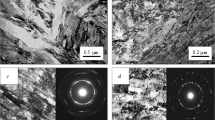Methods of transmission electron microscopy and x-ray diffraction analysis are used to study the structure of nanocrystalline layers formed on the surface of strip specimens of quenched and quenched-and-tempered at 400°C spring steel 70S2KhA as a result of friction loading by a hard-alloy indenter.


Similar content being viewed by others
Notes
The values of σ0.03 are presented only for the tempered specimens. This is connected with the specificity of the method of measurement of this characteristic under bending loads; the attempts to fit quenched ribbon specimens into the measuring ring resulted in their brittle fracture.
References
L. G. Korshunov, A. V. Makarov, and I. L. Chernenko, “Nanocrystalline friction structures in steels and alloys, their strength and tribological properties,” in: Advancement of the Ideas of Academician V. D. Sadovsky, Coll. Works [in Russian], IFM UrO RAN, Ekaterinburg (2008), pp. 218 – 241.
A, G. Rakhshtadt, Spring Steels and Alloys [in Russian], Metallurgiya, Moscow (1982), 400 p.
V. R. Baraz and O. N. Fedorenko, “Effect of friction deformation on the structure and properties of a metastable austenitic chromium-nickel steel,” Deform. Razrush. Mater., No. 12, 15 – 18 (2011).
S. S. Gorelik, L. M. Rastorguev, and Yu. A. Skakov, X-ray Diffraction and Electron Optical Analysis [in Russian], Metallurgiya, Moscow (1990), 366 p.
M. M. Umanskii and Z. K. Zolina, Problems in x-ray Diffraction Analysis [in Russian], Izd. MGU, Moscow (1975), 232 p.
V. Ya. Zubov, “Determination of conventional yield strength of spring ribbon under pure bending,” Zavod. Lab., No. 12, 1486 – 1487 (1949).
L. G. Korshunov, A. V. Makarov, and N. D. Chernenko, “Structural aspects of wear resistance of steels of martensitic class,” Fiz. Met. Metalloved., 78(4), 128 – 146 (1994).
I. P. Hirth and D. A. Rigney, “The application of dislocation concepts in friction and wear” in: F. R. N. Nabarro (ed.), Dislocations in Solids (1983), Vol. 6, Ch. 25, pp. 3 – 54.
P. Heilmann, W. A. Clark, and D. A. Rigney, “Orientation determination of subsurface cells generated by sliding,” Acta Metall., 31(8), 1293 – 1305 (1983).
Author information
Authors and Affiliations
Corresponding author
Additional information
Translated from Metallovedenie i Termicheskaya Obrabotka Metallov, No. 4, pp. 40 – 43, April, 2014.
Rights and permissions
About this article
Cite this article
Baraz, V.R., Fedorenko, O.N., Khadyev, M.S. et al. Effect of Friction Deformation on the Structure and Properties of a Martensitic Spring Steel. Met Sci Heat Treat 56, 210–213 (2014). https://doi.org/10.1007/s11041-014-9733-x
Published:
Issue Date:
DOI: https://doi.org/10.1007/s11041-014-9733-x




